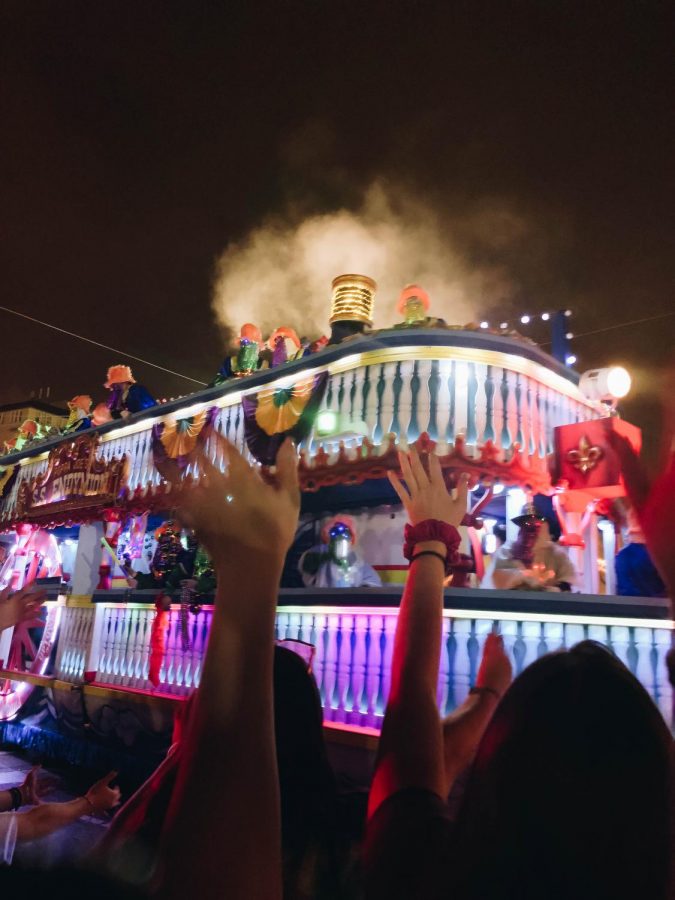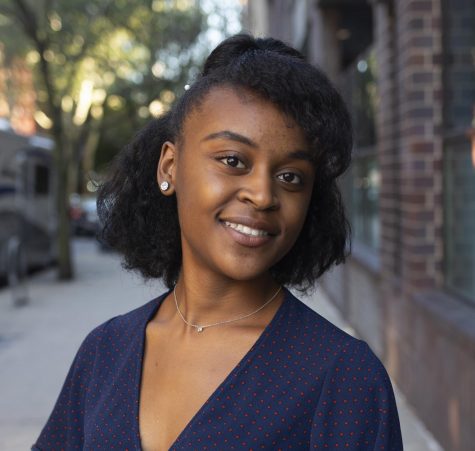Let the Good Times Roll with Mardi Gras
Mardi Gras celebrations in New Orleans, Louisiana, include many colorful costumes and parades.
February 12, 2018
Born in the Big Easy, my sisters and I were always excited to build cardboard floats filled with candy and beads to imitate the huge floats that flooded the French Quarter and Bourbon Street for Mardi Gras parades. If I was lucky, I’d be the one to find the small plastic baby inside the tasty purple, green and gold King Cake. I remember going to parades and seeing the second-liners fill the streets, catching beads thrown to us from the floats above and being picked up in the wave of bounce music, jazz bands and dancers. And how could I forget gathering to eat crawfish and gumbo after the long day of festivities? If only I could go back.
Mardi Gras is a Christian holiday celebrated in many countries throughout the world with large Roman Catholic populations. Mardi Gras, which falls on Feb. 13 this year, directly translates to “Fat Tuesday” from French. The name of the holiday originated thousands of years ago in Europe because of the binge eating that would occur in the days leading up to Lent, the period of fasting between Ash Wednesday and Easter Sunday.
Fat Tuesday can fall on any Tuesday between Feb. 3 and March 9 and is the biggest and perhaps the most important day of celebration. However, the exciting Carnival celebrations go on from Jan. 6, the Twelfth Night or Feast of Epiphany, until the midnight of Fat Tuesday.
When Christianity spread from Rome to various parts of the world, so did Mardi Gras. Today, Brazil, Venice and New Orleans are among the top places in the world to celebrate the festivities of the holiday, attracting thousands of tourists every year.
Tisch freshman Abby Tawiah doesn’t feel that she can personally identify with Mardi Gras.
“I’ve never been one to celebrate a holiday that I have no connection to,” Tawiah said. “I’m from West Africa and have no family from here. I’m sure the holiday means more to the native people of Orleans, and I wouldn’t want to appropriate that.”
Due to the French influence in New Orleans, Mardi Gras remains a rich custom for the Cajun and Creole people of Louisiana. Krewes, which are organizations that arrange parades during the carnival season, have remained a paramount part of the carnival culture in New Orleans over the years. There are tons of Krewes in New Orleans, such as the Krewe of Zulu, the Mardi Gras Indians and many others.
Nonetheless, we can give credit to the Krewe of Rex for establishing purple, green and gold as the official colors of Mardi Gras. Each color has a special meaning: purple symbolizes justice, gold signifies power and green represents faith.
Colored purple, green and gold, King Cake is essential for any Mardi Gras celebration. This cake, rich in color and flavor, originated in France in 1870 as a cross between a coffee cake and a French pastry. In every glittery King Cake comes a tiny doll, which many people say represents baby Jesus. The meaning of finding the baby in the cake isn’t very clear, but it either signifies prosperity and good luck or marks you as responsible for providing a King Cake at the next celebration.
While most NYU students have heard of Mardi Gras, few students plan to celebrate the festive holiday this year. CAS freshman Lauren Rodriguez stated that she did not share the excitement of some of her peers.
“Yeah, I’ve heard of Mardi Gras before, but I don’t plan to celebrate it this year,” Rodriguez said.
CAS freshman Charlotte Dankwah is not celebrating the festival this year.
“I’ve heard of Mardi Gras, and I know that it’s a big French holiday celebrated in Louisiana,” Dankwah said. “I even know of a few events happening in [New York City] to celebrate, but I’m just too busy to go.”
SPS freshman Matthew Oscodar is more willing to see how New York City celebrates Mardi Gras.
“I’d be willing to celebrate it if I knew of any events happening here in the city,” Oscodar said.
Some students, like Steinhardt senior Marco Chan, are trying to keep the Mardi Gras spirit alive even if they are not in New Orleans.
“I have heard of Mardi Gras but never celebrated it in the past,” Chan said. “But this week, the [Faculty Fellows in Residence] on [Lipton Residence Hall’s] 11th floor are having a party in their room to celebrate and will be welcoming residents in with foods from Louisiana. I definitely plan to stop by.”
The city that never sleeps doesn’t sleep on this holiday either. There are various bars, jazz lounges and dance clubs that give you a taste of the Big Easy right here in the Big Apple. If you want a funk-filled night, check out B.B. King Blues Club & Grill. The House of Yes in Brooklyn is hosting its annual Mardi Gras event with circus performances, good company and great music. Whether you plan to travel down to Canal Street in New Orleans for the holiday or Canal Street in New York City, Mardi Gras is a time of fun and celebration that everyone should experience.
A version of this article appeared in the Feb. 12 print edition. Email Tianne Johnson at [email protected]
















































































































































